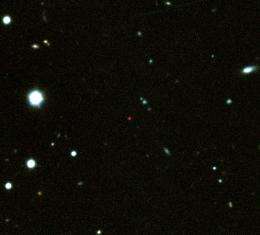Astronomers explore 'last blank space' on map of the Universe

(PhysOrg.com) -- The most distant object ever discovered is described in this week's edition of the science journal Nature. Two international teams of astronomers report their observations of a gamma-ray burst from a star that died when the Universe was 640 million years old, or less than 5 percent of its present age.
Dubbed GRB 090423, the record-breaker is an example of the brightest and most violent explosions known to exist. The explosion is thought to accompany the catastrophic death of a very massive star as it ended its life, and is triggered by the centre of the star collapsing to form a black hole.
"This observation allows us to begin exploring the last blank space on our map of the Universe", said Professor Nial Tanvir of the University of Leicester, who led one of the teams.
Although the gamma-ray burst itself occurred about 630 million years after the Big Bang, it is so far away (about 13.1 billion light years) that the light from the explosion only arrived at the Earth in April of this year. "It is tremendously exciting to be looking back in time to an era when the first stars were just switching on", commented team member Dr Andrew Levan of the University of Warwick.
Much of this light was in the form of very high energy gamma-ray radiation, which triggered the detectors on a NASA satellite called Swift. Following up on the automatic announcement from Swift several of the world's largest telescopes turned to the region of the sky within the next minutes and hours and located the faint, fading afterglow of the GRB. Detailed analysis revealed that the afterglow was seen only in infrared light and not in the normal optical. This was the clue that the burst came from very great distance.
Beyond the mere breaking of a record, the age of the newly detected object opens a window into a cosmological era that has not previously been accessible to observation. The cosmic "Dark Ages" are thought to have ended about 800-900 million years after the Big Bang, when light from stars and galaxies re-ionized the previously neutral gas pervading the Universe. As more gamma-ray bursts are detected from these early times, it should be possible to trace the progress of this re-ionization, leading to the intergalactic medium we see today.
Gamma-ray bursts are the Universe's most luminous explosions. Most occur when massive stars run out of nuclear fuel. As their cores collapse into a black hole or neutron star, gas jets -- driven by processes not fully understood -- punch through the star and blast into space. There, they strike gas previously shed by the star and heat it, which generates short-lived afterglows in other wavelengths.
The previous record holder was a burst with a redshift of 6.7, which places it 180 million light-years closer than GRB 090423.
Provided by Science and Technology Facilities Council (news : web)




















